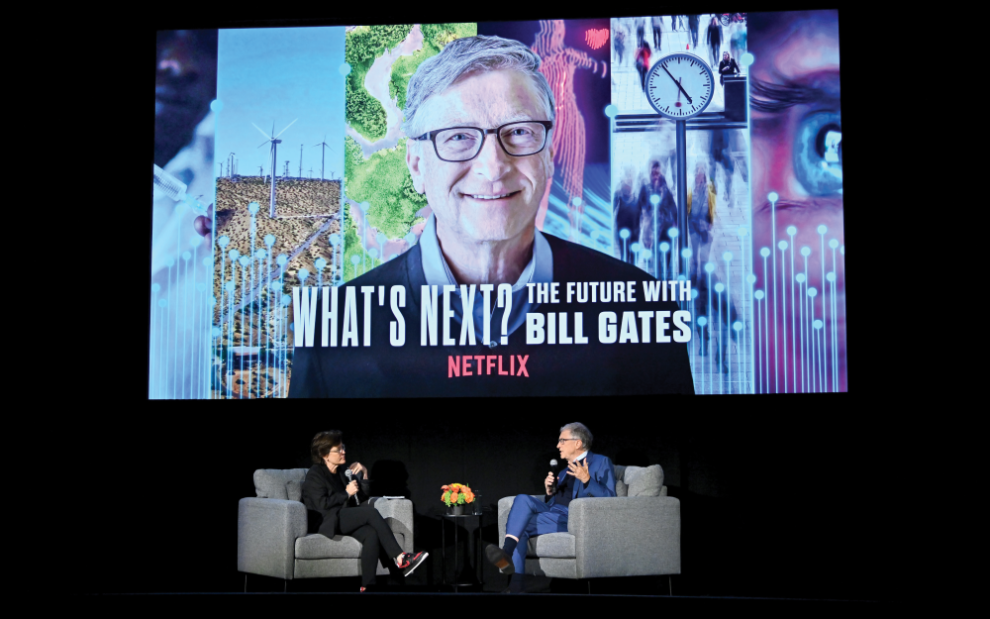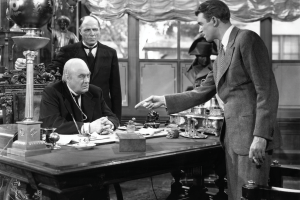Millions of people all over the world would probably be eager to sit at the feet of Microsoft cofounder Bill Gates, basking in his brilliance. That may be why, in less than five years, he’s become the subject of two Netflix series by Oscar-winning documentarians. In 2019, Davis Guggenheim, director of Al Gore’s An Inconvenient Truth, produced Inside Bill’s Brain: Decoding Bill Gates, a three-parter. Then, in September 2024, Netflix dropped What’s Next: The Future with Bill Gates, produced by Morgan Neville (20 Feet from Stardom and Won’t You Be My Neighbor?).
Each of the five segments of What’s Next focuses on a big problem that looms over the 21st century: artificial intelligence, disinformation, climate change, economic inequality, and public health. In each segment, an off-camera interviewer pumps Gates for his wisdom. Gates also conducts his own interviews with celebrities, including Lady Gaga, James Cameron, and, of all people, Bernie Sanders. In between, Gates takes us to some of the projects and people the Bill and Melinda Gates Foundation funds.
The AI segment is perhaps the thinnest. We get scenes of Gates and Open AI CEO Sam Altman laughing at their accomplishments and fawning over each other’s greatness. We hear from a Washington Post tech reporter who keeps referring to ChatGPT with personal pronouns, and we see segments from a Goldman Sachs-sponsored AI Forward conference. In between, snazzy, presumably AI-generated graphics fill the screen. However, at no time do we hear anything about the huge for-profit investments Gates’ company Microsoft has made in Open AI, even though Open AI is now essentially a division of Microsoft. Nor do we visit any of the millions of impoverished people in the Global South who are tethered to laptops all day for about a dollar an hour, tagging data to train AI.
In the episode on disinformation, Gates interviews Lady Gaga, who’s presumed to be an expert on the topic because of the vile internet rumors about her. For the most part, though, the episode deals with online conspiracy theories about Gates himself, including the wild claim that he was putting a tracking microchip in each dose of the COVID-19 vaccine.
Throughout the hour, people keep addressing Gates as if he’s one of the internet’s inventors, but, in fact, Microsoft was comparatively late in joining the online world. Only a brief mention is made of a conspiracy theory that says Bill Gates is trying to block the sun. This rumor, however, happens to be sort of true: He’s a big investor in a project to slow global warming by spraying particles into the stratosphere to dim the sun’s rays.
“Certain kinds of blind optimism can be a form of climate denial.”
The climate change episode has one of the best segments in the series. In it, Gates sits at a table with several young climate activists who simply aren’t buying his techno-optimism about carbon offsets and geoengineering. At one point, a young woman looks Gates in the eye and says, “Certain kinds of blind optimism can be a form of climate denial.” He has no reply. The rest of the episode focuses on various techno-fixes for the climate disaster: cleaner, safer nuclear reactors; cleaner, greener concrete; and a sort of reverse-fracking project to inject carbon dioxide into the rock formations beneath Iceland.
Bernie Sanders gets spliced into the episode on economic inequality, presumably to show Gates’ openness to dissenting views. Sanders says there should be no billionaires, an assertion to which Gates stands mute. Also in this episode, Gates claims the United States has made great progress in furthering equality in his lifetime—and that’s an outright falsehood. During the half-century of Gates’ adult life, the unequal distribution of wealth and income in the United States has reverted to 19th-century Gilded Age proportions.
In Gates’ view, however, the only Americans harmed by economic inequality are racial minorities and women. He really says that; the episode’s only examples of economic hardship involve Black people. This is, of course, the Clintonian liberal antidote to Bernie’s “99 percent versus the 1 percent” populist appeal. In that same spirit, this episode also gives us billionaire Mark Cuban saying, “Billionaires aren’t a problem, but a symptom of something special—the American Dream.” Right.
The final episode, titled “Outsmarting Disease” is less troublesome. Gates is funding good work to develop a vaccine for malaria and, in the meantime, supply Africans with mosquito nets and other preventative measures. The filmmakers follow a Nigerian scientist working on the vaccine who tries to avoid local suspicion of “white people’s” injections by inviting traditional village leaders to visit his lab, see the work he is doing, and explain it to their people. Then, as the series concludes, we see Gates at home, listening to some early Dylan on vintage vinyl and nodding sagely while admirers sing his praises.
For all its flaws as a serious treatment of these big issues, What’s Next does at least provide an immersive experience of the post-industrial liberal worldview with all its faith in technical expertise, elite leadership, and free-market economics. According to this perspective, all five of these big problems can be solved simply by setting the smartest people to work on them with resources funneled in by benevolent billionaires. None of these problems could possibly be helped even one little bit by taxing away some of Bill Gates’ wealth, allowing people themselves, through the democratic process, to have a say in their own future.
This article also appears in the February 2025 issue of U.S. Catholic (Vol. 90, No. 2, pages 36-37). Click here to subscribe to the magazine.
Image: Photo by Roy Rochlin/Getty Images for Netflix












Add comment